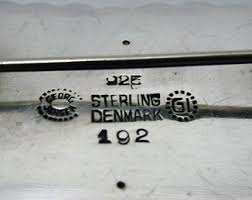Your silver is worth money. But there’s so much more to it than that. Over the nearly 30 years that I’ve spent discovering fascinating new pieces, I’ve taken it upon myself to try and share this deep appreciation of not only the value of some items but the rarity, craftsmanship, history, and stunningly brilliant beauty of the collections people bring to me.
And if that isn’t of interest to you, you’ll be interested in knowing that by being able to identify these traits can help assure you that you get exactly what your silver is worth.
Today we’re going to talk about Silver Hallmarks. Just a drop in the bucket, since this is an entire specialty of knowledge, but an excellent foundation.
Related Blog – Selling Gold and Silver: 4 Rules for Dealing with Antique Buyers
Silver Hallmarks, Silver Markings:
Sterling Silver
Essentially every new silverware set, tea set, etc. you will come across is marked with a stamp called a silver hallmark. The purpose of a silver mark is to tell the buyer (or in this case, you) what the purity of the silver is. The most common markings for sterling silver are fairly easy to decipher:
– Sterling
– 925 or .925

This indicates a 92.5% silver purity. Silver is often blended with other metals for increased strength. You may also see lower percentages of silver, such as 900 or 800. This indicates a lower percentage of silver and is no longer considered ‘Sterling’.
Fine Silver and Silver Plate
Fine Silver, quite simply, is composed of 100% pure silver. Pound for pound this is the most valuable silver you can find. We’ll learn next time what can give ‘pound for pound’ a run for its money. However, for today we’ll keep things simple. Fine Silver can just as easily be identified with the markings such as Fine Silver or Pure Silver. Rogers sterling (often marked Wm Rogers – and also indicated ‘Sterling’) is actually pure silver. Whereas Rogers plated silver is not.

Be wary of items marked as Stainless, Triple Plate, IS, Silver, EPNS, and the like. These indicate that your items are made from stainless steel, electroplated, or are simply silver plated. While these may be beautiful items they are not all that valuable. You may simply want to keep them in your home for your own enjoyment.
Unique Markings
Here’s where things get interesting. Remember what I said in the beginning? There is so much more to Silver than it’s weight in… silver. You will not always come across a marking that is as simple to read as what I’ve outlined above. Markings from around the world vary in more ways than just the country it comes from.
There are literally thousands of these unique markings offering insight into:
– The age of a particular item
– Place of origin
– Rarity
– Manufacturer
– Significance
And so much more.
For a quick example, the image below is a silver marking from the Kirk firm, founded in America in 1815. Samuel Kirk introduced a unique type of repousse decoration that has become known as the Baltimore Style and as since become highly imitated. This marking indicates both the year, location, manufacturer, and historical significance of the piece.

I hope you found this all very informative and exciting! I look forward to sharing more of my appreciation and knowledge about the wonderful works of silver soon. We’ll discuss markings from all over the world and the difference in significance between them.
If you’re eager to discover the true value of your silver right away, I always encourage people to consult a respected expert or two. You can also contact me directly and I’d be happy to answer any of your questions.







